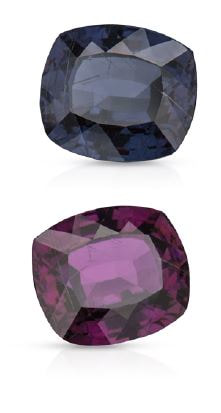GarnetThought to possess calming and restorative powers. The name garnet comes from the medieval Latin
“granatus,” meaning pomegranate, in reference to the similarity in color. Thousands of years ago, red garnet necklaces adorned the necks of Egypt’s pharaohs, and were entombed with their mummies as prized possessions for the afterlife. In ancient Rome, signet rings with carved garnets were used as seals to stamp the wax that secured important documents. Centuries later, during Roman scholar Pliny’s time (23 to 79 CE), red garnets were among the most widely traded gems. In the Middle Ages (about 475 to 1450 CE), red garnet was favored by clergy and nobility. Color Garnets are a set of closely related minerals that form
a group, resulting in gemstones in almost every color. Pyrope and almandine range in color from purple to red. Spessartine is found in a variety of oranges and yellows, while andradite is mostly yellow to green. Grossular has perhaps the widest color range of any garnet species, from colorless through yellow to reddish orange and orangy red, to a strong vibrant green called tsavorite. Clarity Typical garnet clarity depends on garnet type. For
example, the red garnets almandine, pyrope and rhodolite, typically do not have eye-visible inclusions. Some of the orange garnets like spessartine and hessonite, often have eye-visible inclusions. Because inclusions affect its clarity, hessonite is not often used in jewelry. Source With many different garnet species, the sources for this
gem vary. Most tsavorite garnet comes from the East African countries of Tanzania, Kenya and Madagascar. Russia is recognized as the source for high-quality demantoid garnet. Treatments Garnet is rarely treated.
|
Garnets can come in many colors but some have
specific variety names. Purple-red to purple almandine is called rhodolite. Brownish orange grossular is known as hessonite while green grossular is called tsavorite. Green andradite is called demantoid. |
All information are courtesy of Gemological Institute of America (GIA). OR DIAMOND are not affiliated with, connected to, or associated with GIA other than selling diamonds and gemstones graded by GIA and have GIA trained staff gemologist and accredited jewelry professional on site.
Images courtesy: Mayer & Watt, Maysville, Kentucky; Wayne and Dona Leicht





